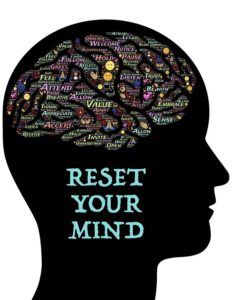
Simple Self-Awareness: Part Three of Three
 Congrats on making it to part three! In part one we discussed the importance of a desire to change, we talked about two types of change we may want to make (creating new and replacing old), and we started to identify some changes that we may want to make. In part two we came back to our list and spent more time connecting with the importance of the “why”, then we started connecting deeper with the actions needed to be successful, and finally we explored what may derail us and some basic strategies to combat this. In this post we’re going to cover how to build awareness of our bad habits and strategy to start working on them.
Congrats on making it to part three! In part one we discussed the importance of a desire to change, we talked about two types of change we may want to make (creating new and replacing old), and we started to identify some changes that we may want to make. In part two we came back to our list and spent more time connecting with the importance of the “why”, then we started connecting deeper with the actions needed to be successful, and finally we explored what may derail us and some basic strategies to combat this. In this post we’re going to cover how to build awareness of our bad habits and strategy to start working on them.Habits are our friends…
 A quick word about habits. They’re awesome and they free up the prefrontal cortex of our brain. This allows us to be creative, deal with complexity, make plans, focus, control impulses, and more. My techie friends will recognize this value as offloading with specialized ASICS, but I digress. Controlling impulses will become more important as we’ll use this to break old habits, but first we’ll need to create more awareness. I do suggest readers learn more about how the brain works, but in this case you’ll want to read more about the limbic system. This article from Positive Psychology is a good read and speaks more to the science about what I’m covering.
A quick word about habits. They’re awesome and they free up the prefrontal cortex of our brain. This allows us to be creative, deal with complexity, make plans, focus, control impulses, and more. My techie friends will recognize this value as offloading with specialized ASICS, but I digress. Controlling impulses will become more important as we’ll use this to break old habits, but first we’ll need to create more awareness. I do suggest readers learn more about how the brain works, but in this case you’ll want to read more about the limbic system. This article from Positive Psychology is a good read and speaks more to the science about what I’m covering.Finding the Gremlins
 Onto the harder changes to address. Bad habits! We all have them and it’s worth reiterating that there’s little value in judging ourselves, or others, over them. Some of the bad habits we’re aware of, but sometimes we’re not. How do we become aware of habits that don’t sit well with others or prevent us from moving forward in our goals? Unless you’re surrounded by people that care about you and have strong candor, as in the type that will tell you about the booger on your face, then the next best option is to pursue a 360-feedback or multi-rater survey tool. Some employers will offer this kind of tool, but there are some options online as well. The first experience I ever had with something like this by accident in my early twenties. It was part of a course I took which focused on organization and time management. Part of me was curious to see how my peers felt about me, but another part was not interested at all! It turned out to be one of the best things I could have done for myself and provided me with many opportunities to improve. Better yet, it opened my mind to the value of feedback and created a desire to make this a regular practice going forward. If a 360 feedback survey is not available, then another option is to simply ask others for feedback. To the extent we make it safe for them to do so, most people are willing to share how they observe and experience us. If you’re aware of something specific you want to work on, then you can prime these topics with others to observe and report back.
Onto the harder changes to address. Bad habits! We all have them and it’s worth reiterating that there’s little value in judging ourselves, or others, over them. Some of the bad habits we’re aware of, but sometimes we’re not. How do we become aware of habits that don’t sit well with others or prevent us from moving forward in our goals? Unless you’re surrounded by people that care about you and have strong candor, as in the type that will tell you about the booger on your face, then the next best option is to pursue a 360-feedback or multi-rater survey tool. Some employers will offer this kind of tool, but there are some options online as well. The first experience I ever had with something like this by accident in my early twenties. It was part of a course I took which focused on organization and time management. Part of me was curious to see how my peers felt about me, but another part was not interested at all! It turned out to be one of the best things I could have done for myself and provided me with many opportunities to improve. Better yet, it opened my mind to the value of feedback and created a desire to make this a regular practice going forward. If a 360 feedback survey is not available, then another option is to simply ask others for feedback. To the extent we make it safe for them to do so, most people are willing to share how they observe and experience us. If you’re aware of something specific you want to work on, then you can prime these topics with others to observe and report back.May cause mood swings

If you’re curious to know what you don’t know, then we’ll explore a different approach. BEFORE YOU MOVE ON, IT’S CRITICAL THAT YOU MAKE IT SAFE FOR OTHERS TO SHARE! This implies that you CAN TAKE the feedback well. If you struggle with this, then my suggestion would be to skip to the next paragraph and assume you got needed feedback from a 360 review. On receiving feedback, I tell others to not respond, but rather say thank you. Understand that you do things you’re not aware of and you’re not a bad person because of it! There are other cases where we know we do it, but we don’t know how to stop or we’re afraid to. Don’t judge yourself. Consider the possibility that others see you in small windows of time and form opinions based on what they observe and experience. We all do it! Assume it’s an accurate reflection and try it on. Consider what you may have been doing, or not doing, that could have led to this impression. If you can avoid reacting poorly, then you want to ask questions such as “When do you find me less persuasive? What do you observe that may cause this?” or “What habits do I have that get on your nerves? When do you see these? Do I always do it?”. Take note of what you’re hearing and avoid trying to shape it in a way that rationalizes it to your ego. Once you try on the clothes, then you have to consider if you want to keep them. There are times where we decide we don’t need or want to work on something and this is not a problem. You’ll want to consider whether your short-term or long-term goals are at risk if you choose to not work on the area identified.
Seek more knowledge
 Assuming we have received feedback, we’ll want to learn as much as we can. We’ll want to know what the environment is like when the habit is active, is it consistent or intermittent, and how do we feel when it’s intermittent. The more we study the behavior and the state in in which it occurs, the more insight we’ll have to start working on it. This can take time to get in touch with, so be patient. Becoming self-aware is a continual practice and, like a muscle, will get stronger over time as we exercise it. That said, if you’ve not been doing any physical exercise, expecting to be the next crossfit champion in a few weeks is going to lead to frustration. The same applies here…patience and practice is the way.
Assuming we have received feedback, we’ll want to learn as much as we can. We’ll want to know what the environment is like when the habit is active, is it consistent or intermittent, and how do we feel when it’s intermittent. The more we study the behavior and the state in in which it occurs, the more insight we’ll have to start working on it. This can take time to get in touch with, so be patient. Becoming self-aware is a continual practice and, like a muscle, will get stronger over time as we exercise it. That said, if you’ve not been doing any physical exercise, expecting to be the next crossfit champion in a few weeks is going to lead to frustration. The same applies here…patience and practice is the way.And now for something completely different!
 We address this situation by finding alternative actions to take provide the same value and then we start practicing them. What other ways could we check-in with our audience to see if they’re still with us? Instead of saying “Blah blah blah…cool technology blah blah awesome blah blah….right?” we could say “I’m finding this technology is heating up and may have potential to displace others in this space. Is anyone else experiencing or seeing this?”. We could also invite others to provide opposing views or other perspectives to consider and then we move on with our goal. If it’s to persuade, then we support our position while inviting perspective to consider and work through. If we’re trying to inform, then we should continue to do so. The point we’ll take from here is that we have an alternative behavior to practice.
We address this situation by finding alternative actions to take provide the same value and then we start practicing them. What other ways could we check-in with our audience to see if they’re still with us? Instead of saying “Blah blah blah…cool technology blah blah awesome blah blah….right?” we could say “I’m finding this technology is heating up and may have potential to displace others in this space. Is anyone else experiencing or seeing this?”. We could also invite others to provide opposing views or other perspectives to consider and then we move on with our goal. If it’s to persuade, then we support our position while inviting perspective to consider and work through. If we’re trying to inform, then we should continue to do so. The point we’ll take from here is that we have an alternative behavior to practice.